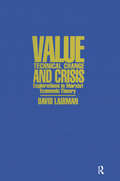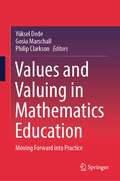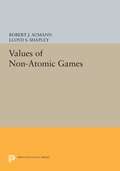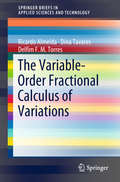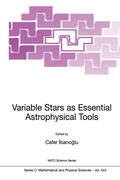- Table View
- List View
The Value of Information: Methodological Frontiers and New Applications in Environment and Health
by Ramanan Laxminarayan and Molly K. MacauleyThe book examines applications in two disparate fields linked by the importance of valuing information: public health and space. Researchers in the health field have developed some of the most innovative methodologies for valuing information, used to help determine, for example, the value of diagnostics in informing patient treatment decisions. In the field of space, recent applications of value-of-information methods are critical for informing decisions on investment in satellites that collect data about air quality, fresh water supplies, climate and other natural and environmental resources affecting global health and quality of life.
Value of Information for Healthcare Decision-Making (Chapman & Hall/CRC Biostatistics Series)
by Anna Heath Natalia Kunst Christopher JacksonValue of Information for Healthcare Decision-Making introduces the concept of Value of Information (VOI) use in health policy decision-making to determine the sensitivity of decisions to assumptions, and to prioritise and design future research. These methods, and their use in cost-effectiveness analysis, are increasingly acknowledged by health technology assessment authorities as vital. Key Features: Provides a comprehensive overview of VOI Simplifies VOI Showcases state-of-the-art techniques for computing VOI Includes R statistical software package Provides results when using VOI methods Uses realistic decision model to illustrate key concepts The primary audience for this book is health economic modellers and researchers, in industry, government, or academia, who wish to perform VOI analysis in health economic evaluations. It is relevant for postgraduate researchers and students in health economics or medical statistics who are required to learn the principles of VOI or undertake VOI analyses in their projects. The overall goal is to improve the understanding of these methods and make them easier to use.
Value of Information for Healthcare Decision-Making (Chapman & Hall/CRC Biostatistics Series)
Value of Information for Healthcare Decision-Making introduces the concept of Value of Information (VOI) use in health policy decision-making to determine the sensitivity of decisions to assumptions, and to prioritise and design future research. These methods, and their use in cost-effectiveness analysis, are increasingly acknowledged by health technology assessment authorities as vital. Key Features: Provides a comprehensive overview of VOI Simplifies VOI Showcases state-of-the-art techniques for computing VOI Includes R statistical software package Provides results when using VOI methods Uses realistic decision model to illustrate key concepts The primary audience for this book is health economic modellers and researchers, in industry, government, or academia, who wish to perform VOI analysis in health economic evaluations. It is relevant for postgraduate researchers and students in health economics or medical statistics who are required to learn the principles of VOI or undertake VOI analyses in their projects. The overall goal is to improve the understanding of these methods and make them easier to use.
The Value of Information Updating in New Product Development (Lecture Notes in Economics and Mathematical Systems #620)
by Christian ArtmannManaging uncertainty in new product development projects for improved valuation and decision making is one of the most complex and challenging problems in operations management. It is important for any corporation depending on the success of new products and innovations. This work shows how uncertainty can be handled and partly resolved by conducting an information update during the development process. It is one of the first comprehensive models that combine statistical decision theory in form of Bayesian analysis with a real options framework for projects exposed to different sources of uncertainty. The proposed framework makes an important theoretical contribution in addressing this problem, while at the same time being of significant value to managers who face the difficult task of evaluating and managing complex product development projects.
The Value of Signals in Hidden Action Models: Concepts, Application, and Empirical Evidence (Contributions to Economics)
by Wendelin SchnedlerSince the fundamental work of Walras (1874), markets have received particular attention by economists because they lead to an efficient allocation of goods and services. However, the proper functioning of markets rests on certain assumptions. For instance, the good or ser vice which is to be traded must be clearly defined. This elementary requirement is often violated in reality, in particular when services are concerned. Consider the example of railway workers who are hired to lay tracks. A labour contract which stipulates a fixed wage and defines the workers' task as "laying tracks" is rather unspecific. Workers may profit from this vagueness by reducing effort to a comfortable amount -as long as tracks are laid, they do not violate contract conditions. Thus, an im precise definition of the service can result in inefficiently low efforts. An obvious solution to this problem is a clearer definition of the ser vice, but often this way is barred: To specify, for instance, all actions which are involved in laying tracks and which may vary with weather, surface and other conditions is far too complicated and too costly. In deed, labour contracts seldom give a detailed account of the task of a worker. Alternatively to a more precise task description, the wage of the worker could be conditioned on information about the worker's performance. For example, the railway workers might be paid by the length of tracks laid so that they are motivated to exert more effort.
Value-Oriented Risk Management of Insurance Companies (EAA Series)
by Marcus Kriele Jochen WolfValue- and risk-oriented management is a holistic method of managing businesses. In this book both actuarial methods and methods pertaining to classical internal control and classical risk management are used. Therefore the approach taken is necessarily interdisciplinary. Indeed, there is a new dynamically developing field for actuaries as a result of the emphasis now on the measurement of risk.This book provides the required basic knowledge for this subject from an actuarial perspective. It enables the reader to implement in practice a risk management system that is based on quantitative methods. With this book, the reader will additionally be able to critically appraise the applicability and the limits of the methods used in modern risk management.Value-oriented Management of Risk in Insurance focuses on risk capital, capital allocation, performance measurement and value-oriented management. It also makes a connection to regulatory developments (for example, Solvency II). The reader should have a basic knowledge of probability and familiarity with mathematical concepts. It is intended for working actuaries and quantitative risk managers as well as actuarial students.
Value, Technical Change and Crisis: Explorations in Marxist Economic Theory
by David LaibmanThis text brings together studies in various aspects of the theory of the capitalist economy. It focuses on major themes of the Marxist tradition that postulate the existence and importance of social relations and structures underlying the esoteric realm of economic categories: prices, profits, wages, etc. The author takes a reappraising, critical look at the concepts of the deep structure - value, explitation, immanent crisis - using the analytical tools of modern economics to improve those concepts. The book is divided into four parts. Part 1 explores the essential nature of capitalism, re-examining problems in the theory of value and exploitation. Part 2 tackles the issue of capitalism-specific paths of growth and technical change, putting forward a rigorous theory of biased technical change and non-steady-state growth. Part 3 examines the cyclical character of capitalist growth and the theory of crises. Finally, Part 4 places capitalism in the wider framework of modes of production, considering the theory of precapitalist formations and aspects of the theory and practical experience of socialism. The guiding theme is the combination, or confrontation, of rigorous, quantitative analytical techniques with equally demanding qualitative and political-economic conceptualization. The book's premise is that this interface is essential to a progressive yet distinctively Marxist social theory.
Value, Technical Change and Crisis: Explorations in Marxist Economic Theory
by David LaibmanThis text brings together studies in various aspects of the theory of the capitalist economy. It focuses on major themes of the Marxist tradition that postulate the existence and importance of social relations and structures underlying the esoteric realm of economic categories: prices, profits, wages, etc. The author takes a reappraising, critical look at the concepts of the deep structure - value, explitation, immanent crisis - using the analytical tools of modern economics to improve those concepts. The book is divided into four parts. Part 1 explores the essential nature of capitalism, re-examining problems in the theory of value and exploitation. Part 2 tackles the issue of capitalism-specific paths of growth and technical change, putting forward a rigorous theory of biased technical change and non-steady-state growth. Part 3 examines the cyclical character of capitalist growth and the theory of crises. Finally, Part 4 places capitalism in the wider framework of modes of production, considering the theory of precapitalist formations and aspects of the theory and practical experience of socialism. The guiding theme is the combination, or confrontation, of rigorous, quantitative analytical techniques with equally demanding qualitative and political-economic conceptualization. The book's premise is that this interface is essential to a progressive yet distinctively Marxist social theory.
Valued Fields (Springer Monographs in Mathematics)
by Antonio J. Engler Alexander PrestelAbsolute values and their completions – such as the p-adic number fields – play an important role in number theory. Krull's generalization of absolute values to valuations made possible applications in other branches of mathematics. In valuation theory, the notion of completion must be replaced by that of "Henselization". This book develops the theory of valuations as well as of Henselizations, based on the skills of a standard graduate course in algebra.
Values and Valuing in Mathematics Education: Scanning and Scoping the Territory (ICME-13 Monographs)
by Philip Clarkson Wee Tiong Seah JeongSuk PangThis engaging open access book discusses how a values and valuing perspective can facilitate a more effective mathematics pedagogical experience, and allows readers to explore multiple applications of the values perspective across different education systems. It also clearly shows that teaching mathematics involves not only reasoning and feelings, but also students’ interactions with their cultural setting and each other.The book brings together the work of world leaders and new thinkers in mathematics educational research to improve the learning and teaching of mathematics. Addressing themes such as discovering hidden cultural values, a multicultural society and methodological issues in the investigation of values in mathematics, it stimulates readers to consider these topics in cross-cultural ways, and offers suggestions for research and classroom practice.It is a valuable resource for scholars of mathematics education, from early childhood through to higher education and an inspiring read for all mathematics teachers.
Values and Valuing in Mathematics Education: Moving Forward into Practice
by Yüksel Dede Gosia Marschall Philip ClarksonThis book is a follow-up to 'Values and Valuing in Mathematics Education: Scanning and Scoping the Territory' (2019, Springer). This book adds a critical emphasis on practice and fosters thinking concerning positive mathematical well-being, engagement, teacher noticing, and values alignment among a range of critical notions that intersect with values and valuing. Values and valuing play a key role in many aspects of education, such as assessment, planning, classroom interactions, choosing tasks, and general well-being. What one values and finds important in the learning and teaching of mathematics operates within the intersection of all social, cognitive, and affective aspects of school pedagogy, making values a significant holistic factor in education. The chapters explore potential teaching strategies that enhance the understanding of the central place of values in mathematics itself as a subject, as well as how values impact how mathematics is used withinsociety. This book includes examples of strategies for facilitating students’ meaningful engagement with, and conscious learning of, values when engaging in mathematical thinking and doing.
Values of Non-Atomic Games
by Robert J. Aumann Lloyd S. ShapleyThe "Shapley value" of a finite multi- person game associates to each player the amount he should be willing to pay to participate. This book extends the value concept to certain classes of non-atomic games, which are infinite-person games in which no individual player has significance. It is primarily a book of mathematics—a study of non-additive set functions and associated linear operators.Originally published in 1974.The Princeton Legacy Library uses the latest print-on-demand technology to again make available previously out-of-print books from the distinguished backlist of Princeton University Press. These editions preserve the original texts of these important books while presenting them in durable paperback and hardcover editions. The goal of the Princeton Legacy Library is to vastly increase access to the rich scholarly heritage found in the thousands of books published by Princeton University Press since its founding in 1905.
Valuing Environmental Amenities Using Stated Choice Studies: A Common Sense Approach to Theory and Practice (The Economics of Non-Market Goods and Resources #8)
by Barbara J. KanninenThis book provides practical, research-based advice on how to conduct high-quality stated choice studies. It covers every aspect of the topic, from planning and writing the survey, to analyzing results, to evaluating quality. There is no other book on the market today that so thoroughly addresses the methodology of stated choice. Chapters are written by top-notch academics and practitioners in an accessible style, offering practical, tough advice.
Van Vollenhoven on Indonesian Adat Law (Verhandelingen van het Koninklijk Instituut voor Taal-, Land- en Volkenkunde)
by Cornelis van Vollenhoven J.F. Holleman H.W.J. Sonius Koninklijk Instituut voor Taal-, Land- en VolkenkundeVanishing and Finiteness Results in Geometric Analysis: A Generalization of the Bochner Technique (Progress in Mathematics #266)
by Stefano Pigola Marco Rigoli Alberto G SettiThis book describes very recent results involving an extensive use of analytical tools in the study of geometrical and topological properties of complete Riemannian manifolds. It analyzes in detail an extension of the Bochner technique to the non compact setting, yielding conditions which ensure that solutions of geometrically significant differential equations either are trivial (vanishing results) or give rise to finite dimensional vector spaces (finiteness results). The book develops a range of methods, from spectral theory and qualitative properties of solutions of PDEs, to comparison theorems in Riemannian geometry and potential theory.
Variable Income Equivalence Scales: An Empirical Approach (Contributions to Economics)
by Carsten Schröder1.1 A Brief Overview An extensive body of empirical and theoretical literature deals with the mea surement of social welfare. This body can be decomposed in several different but related topics, all of which have implications for empirical studies in wel fare economics. One of these topics are household equivalence scales which help to compare welfare levels across households that differ in composition. An equivalence scale relates the income of any arbitrary household type to the income ofa referencehouseholdsuch that both households are equally well-off. Differences in household needs arise from differences in the households' de mographic composition which is, for instance, given by the number, age, and sex of the household members. The increase of household needs is not neces sarily proportional to the increase in the number of household members. Such a non-proportionality, for example, results from differences in the needs of adults and children, economies ofscale arising from the division of fixed costs among the household members, welfare gains from household production, and from common consumption ofcommodities bearing a within-household public good component.
Variable Lebesgue Spaces: Foundations and Harmonic Analysis (Applied and Numerical Harmonic Analysis)
by David V. Cruz-Uribe Alberto FiorenzaThis book provides an accessible introduction to the theory of variable Lebesgue spaces. These spaces generalize the classical Lebesgue spaces by replacing the constant exponent p with a variable exponent p(x). They were introduced in the early 1930s but have become the focus of renewed interest since the early 1990s because of their connection with the calculus of variations and partial differential equations with nonstandard growth conditions, and for their applications to problems in physics and image processing. The book begins with the development of the basic function space properties. It avoids a more abstract, functional analysis approach, instead emphasizing an hands-on approach that makes clear the similarities and differences between the variable and classical Lebesgue spaces. The subsequent chapters are devoted to harmonic analysis on variable Lebesgue spaces. The theory of the Hardy-Littlewood maximal operator is completely developed, and the connections between variable Lebesgue spaces and the weighted norm inequalities are introduced. The other important operators in harmonic analysis - singular integrals, Riesz potentials, and approximate identities - are treated using a powerful generalization of the Rubio de Francia theory of extrapolation from the theory of weighted norm inequalities. The final chapter applies the results from previous chapters to prove basic results about variable Sobolev spaces.
Variable Lebesgue Spaces and Hyperbolic Systems (Advanced Courses in Mathematics - CRM Barcelona)
by David Cruz-Uribe Alberto Fiorenza Michael Ruzhansky Jens WirthThis book targets graduate students and researchers who want to learn about Lebesgue spaces and solutions to hyperbolic equations. It is divided into two parts.Part 1 provides an introduction to the theory of variable Lebesgue spaces: Banach function spaces like the classical Lebesgue spaces but with the constant exponent replaced by an exponent function. These spaces arise naturally from the study of partial differential equations and variational integrals with non-standard growth conditions. They have applications to electrorheological fluids in physics and to image reconstruction. After an introduction that sketches history and motivation, the authors develop the function space properties of variable Lebesgue spaces; proofs are modeled on the classical theory. Subsequently, the Hardy-Littlewood maximal operator is discussed. In the last chapter, other operators from harmonic analysis are considered, such as convolution operators and singular integrals. The text is mostly self-contained, with only some more technical proofs and background material omitted. Part 2 gives an overview of the asymptotic properties of solutions to hyperbolic equations and systems with time-dependent coefficients. First, an overview of known results is given for general scalar hyperbolic equations of higher order with constant coefficients. Then strongly hyperbolic systems with time-dependent coefficients are considered. A feature of the described approach is that oscillations in coefficients are allowed. Propagators for the Cauchy problems are constructed as oscillatory integrals by working in appropriate time-frequency symbol classes. A number of examples is considered and the sharpness of results is discussed. An exemplary treatment of dissipative terms shows how effective lower order terms can change asymptotic properties and thus complements the exposition.
Variable Neighborhood Search: 6th International Conference, ICVNS 2018, Sithonia, Greece, October 4–7, 2018, Revised Selected Papers (Lecture Notes in Computer Science #11328)
by Angelo Sifaleras Said Salhi Jack BrimbergThis book constitutes the refereed post-conference proceedings of the 6th International Conference on Variable Neighborhood Search, ICVNS 2018, held in Sithonia, Greece, in October 2018. ICVNS 2018 received 49 submissions of which 23 full papers were carefully reviewed and selected. VNS is a metaheuristic based on systematic changes in the neighborhood structure within a search for solving optimization problems and related tasks. The main goal of ICVNS 2018 was to provide a stimulating environment in which researchers coming from various scientific fields could share and discuss their knowledge, expertise, and ideas related to the VNS metaheuristic and its applications.
The Variable-Order Fractional Calculus of Variations (SpringerBriefs in Applied Sciences and Technology)
by Ricardo Almeida Dina Tavares Delfim F. TorresThe Variable-Order Fractional Calculus of Variations is devoted to the study of fractional operators with variable order and, in particular, variational problems involving variable-order operators. This brief presents a new numerical tool for the solution of differential equations involving Caputo derivatives of fractional variable order. Three Caputo-type fractional operators are considered, and for each one, an approximation formula is obtained in terms of standard (integer-order) derivatives only. Estimations for the error of the approximations are also provided. The contributors consider variational problems that may be subject to one or more constraints, where the functional depends on a combined Caputo derivative of variable fractional order. In particular, they establish necessary optimality conditions of Euler–Lagrange type. As the terminal point in the cost integral is free, as is the terminal state, transversality conditions are also obtained.The Variable-Order Fractional Calculus of Variations is a valuable source of information for researchers in mathematics, physics, engineering, control and optimization; it provides both analytical and numerical methods to deal with variational problems. It is also of interest to academics and postgraduates in these fields, as it solves multiple variational problems subject to one or more constraints in a single brief.
Variable Ordering Structures in Vector Optimization (Vector Optimization)
by Gabriele EichfelderThis book provides an introduction to vector optimization with variable ordering structures, i.e., to optimization problems with a vector-valued objective function where the elements in the objective space are compared based on a variable ordering structure: instead of a partial ordering defined by a convex cone, we see a whole family of convex cones, one attached to each element of the objective space. The book starts by presenting several applications that have recently sparked new interest in these optimization problems, and goes on to discuss fundamentals and important results on a wide range of topics. The theory developed includes various optimality notions, linear and nonlinear scalarization functionals, optimality conditions of Fermat and Lagrange type, existence and duality results. The book closes with a collection of numerical approaches for solving these problems in practice.
Variable Stars as Essential Astrophysical Tools: Proceeding of the NATO Advanced Study Institute on Variable Stars as Essential Astrophysical Tools Çe?me, Turkey August 31 - September 10, 1998 (Nato Science Series C: #544)
by Cafer IbanogammaluPulsating and eccentric binary stars play a fundamentally important role in deciphering the mass distribution within stars. The present volume reviews the fundamental concepts of both radial and nonradial oscillations in the stars, including the Sun. Helio- and astroseismological results are reviewed, from the basics to the most recent developments. A new theory is presented, which seems to explain the mechanism of the light and radial velocity variations of recently discovered Ap stars. This textbook covers almost all kinds of variable stars of widely different characteristics. It will serve as a reference text for a very long time to come, not only for specialists but also for undergraduate students of physics and astronomy.
Variable-Structure Approaches: Analysis, Simulation, Robust Control and Estimation of Uncertain Dynamic Processes (Mathematical Engineering)
by Andreas Rauh Luise SenkelThis edited book aims at presenting current research activities in the field of robust variable-structure systems. The scope equally comprises highlighting novel methodological aspects as well as presenting the use of variable-structure techniques in industrial applications including their efficient implementation on hardware for real-time control. The target audience primarily comprises research experts in the field of control theory and nonlinear dynamics but the book may also be beneficial for graduate students.
Variable Structure Systems: Towards the 21st Century (Lecture Notes in Control and Information Sciences #274)
by Xinghuo Yu Jian-Xin XuThe book is a collection of contributions concerning the theories, applications and perspectives of Variable Structure Systems (VSS). Variable Structure Systems have been a major control design methodology for many decades. The term Variable Structure Systems was introduced in the late 1950’s, and the fundamental concepts were developed for its main branch Sliding Mode Control by Russian researchers Emelyanov and Utkin. The 20th Century has seen the formation and consolidation of VSS theory and its applications. It has also seen an emerging trend of cross-fertilization and integration of VSS with other control and non-control techniques such as feedback linearization, ?atness, passivity based control, adaptive and learning ? control, system identi?cation, pulse width modulation, H geometric and algebraic methods, arti?cial intelligence, modeling and optimization, neural networks, fuzzy logic, to name just a few. This trend will continue and ?ourish in the new millennium. To re?ect these major developments in the 20th Century, this book - cludes 16 specially invited contributions from well-known experts in VSS theory and applications, covering a wide range of topics. The ?rst chapter, “First Stage of VSS: People and Events” written by Vadim Utkin, the founder of VSS, oversees and documents the historical developments of VSS in the 20th Century, including many interesting events not known to the West until now. The second chapter, “An Integrated Learning Variable Structure Control Method” written by Jian-Xin Xu, addresses an important issue regarding control integration between variable structure control and learning control.
Variance Components (Wiley Series in Probability and Statistics #391)
by Shayle R. Searle George Casella Charles E. McCullochWILEY-INTERSCIENCE PAPERBACK SERIES The Wiley-Interscience Paperback Series consists of selected books that have been made more accessible to consumers in an effort to increase global appeal and general circulation. With these new unabridged softcover volumes, Wiley hopes to extend the lives of these works by making them available to future generations of statisticians, mathematicians, and scientists. ". . .Variance Components is an excellent book. It is organized and well written, and provides many references to a variety of topics. I recommend it to anyone with interest in linear models." —Journal of the American Statistical Association "This book provides a broad coverage of methods for estimating variance components which appeal to students and research workers . . . The authors make an outstanding contribution to teaching and research in the field of variance component estimation." —Mathematical Reviews "The authors have done an excellent job in collecting materials on a broad range of topics. Readers will indeed gain from using this book . . . I must say that the authors have done a commendable job in their scholarly presentation." —Technometrics This book focuses on summarizing the variability of statistical data known as the analysis of variance table. Penned in a readable style, it provides an up-to-date treatment of research in the area. The book begins with the history of analysis of variance and continues with discussions of balanced data, analysis of variance for unbalanced data, predictions of random variables, hierarchical models and Bayesian estimation, binary and discrete data, and the dispersion mean model.





